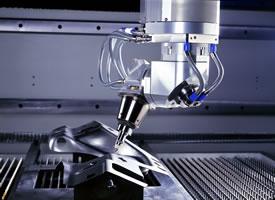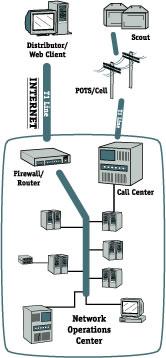President
- FMA
- The Fabricator
- FABTECH
- Canadian Metalworking
Categories
- Additive Manufacturing
- Aluminum Welding
- Arc Welding
- Assembly and Joining
- Automation and Robotics
- Bending and Forming
- Consumables
- Cutting and Weld Prep
- Electric Vehicles
- En Español
- Finishing
- Hydroforming
- Laser Cutting
- Laser Welding
- Machining
- Manufacturing Software
- Materials Handling
- Metals/Materials
- Oxyfuel Cutting
- Plasma Cutting
- Power Tools
- Punching and Other Holemaking
- Roll Forming
- Safety
- Sawing
- Shearing
- Shop Management
- Testing and Measuring
- Tube and Pipe Fabrication
- Tube and Pipe Production
- Waterjet Cutting
Industry Directory
Webcasts
Podcasts
FAB 40
Advertise
Subscribe
Account Login
Search
Site-based telemetry systems streamline gas supply
- By David Bell
- October 12, 2004
- Article
- Consumables
 |
| Photo courtesy of TRUMPF Inc. |
Metal fabricators continue to find new applications for carbon dioxide (CO2) lasers. New uses combined with increased just-in-time processing, and lights-out operation place greater demands on laser, assist, and process gas supply and delivery systems—demands that go well beyond the capabilities of standard compressed gas cylinder systems.
The total materials processing operation depends on each component operating efficiently and continuously, especially the gas supply systems. Whether you're operating a 10-year-old laser machine or evaluating the purchase of a new system, staying up-to-date on current laser cutting technology and techniques can be the key to maintaining a competitive edge.
CO2Laser Gas Requirements
CO2lasers used in materials processing require lasing gases, purging gases, and process or assist gases. To understand the gas requirements used in laser materials processing, you must understand the basic design and operation of a CO2laser and the role of the gases in each process. A CO2laser comprises an active medium (laser gas) placed between two sets of mirrors known as an optical resonator. Energy is supplied to the medium by means of an electrical discharge that excites the medium and starts the spontaneous emission of light.
All CO2lasers use a mixture of helium, nitrogen, and carbon dioxide in the lasing process to excite the medium. Other gases, such as carbon monoxide and hydrogen, may be added to supplement the basic three-gas mixture that normally is required. The lasing action principles are the same for all CO2lasers. Different designs employ different methods of exciting and cooling the gas mixture in the resonator cavity.
The volume of gas used in the lasing process is relatively small; flow rates can be 1 to 2 liters per minute (LPM) (2 to 5 standard cubic feet per hour [SCFH]) or lower. Lasing gases must be supplied with a controlled purity as specified by the laser manufacturer in either pure gas or premix forms. These purity requirements and flow rates dictate lasing gases to be supplied in high-pressure compressed-gas cylinders.
Industrial laser applications require clean, dry house air or dry nitrogen, in addition to the beam-generating gas or gas mixture for proper transmission of the laser beam to the workpiece.
House air can contaminate the optics because most shop air lines contain oil, water, and dirt. Using filters and traps to maintain a certain air purity level can be a time-consuming and expensive procedure.
Dry nitrogen is an economical alternative to house air. Maintaining the proper protection requires nitrogen flow rates of 50 to 85 LPM (100 to 150 SCFH) at pressures of 8 to 12 bar (120 to 225 pounds per square inch gauge [PSIG]). The nitrogen gas must be at the proper purity level and free of oil, moisture, dirt, and other hydrocarbons. Nitrogen purity should be between grade 4.6 (99.996 percent) and Grade 5.0 (99.999 percent) with a maximum of 5 parts per million (PPM) of moisture (H2O) and 1 PPM of total hydrocarbons (THC). The nitrogen can be supplied in high-pressure or liquid cryogenic cylinders. Either will meet the flow and purity requirements.
Lasers perform many different applications, such as cutting, welding, cladding, and marking. These processes might require assist or process gases, the type of which varies according to the process and the material. To achieve the best performance, the process gas must be delivered at the specified pressures and flows.
Oxygen and nitrogen are the primary gases used for laser cutting. Argon, helium, or a mixture of argon and helium normally is used for laser welding. Usually, process gases demand higher pressures and flows than the other gases. In laser cutting, the nitrogen pressure for cutting can be 20 bar (300 PSIG) or higher with flow rates exceeding 3,000 SCFH. Laser welding applications can require argon and helium flow rates in excess of 200 SCFH.
Because of the high volumes used, choosing the most economical supply for process gases is important. Oxygen, nitrogen, and argon can be supplied in cryogenic form, either in liquid cylinders or permanent, on-site bulk stations. Helium and argon/helium mixtures can be supplied only in high-pressure cylinders or more economical cradles (a group of cylinders supplied in a single system) or tube trailers.
Efficiently Monitoring Gas Levels
As mentioned previously, CO2lasers require different gases for different operations. Although independent of each other, each gas is critical to the process. The depletion of one gas can cause a shutdown until the gas can be replenished. Although gas supply systems capable of supplying gases on a continuous basis have existed for many years, the ability to monitor the gases continuously has been limited.
A site-based telemetry system facilitates continuous monitoring of all gases required for laser operation. This system gives gas distributors and laser operators access to gas levels, tank pressure, and line pressure at user locations via the Internet. Centralized reports, information management tools, and integrated fleet routing/scheduling software allow both suppliers and laser users to operate more efficiently. The system can be connected to the PC used for monitoring laser processes. Each gas's supply can be verified quickly before beginning a job.
How Telemetry Works
 |
| Figure 1: How telemetry works. Diagram courtesy of Chart Industries Inc. |
A site-based telemetry system (see Figure 1) uses two types of gas level measuring devices: capacitance probes and load cells. These two devices can monitor nearly any gas supply type or size. In most cases, the capacitance probe can be installed on location, whether the supply is located indoors or outside. Through the system, the distributor receives an accurate measurement of the level of the gas supply.
A phone line-based, two-way-communication device interfaces between the sensors and the site-based network. This device powers and controls the sensors. At regular intervals, it turns the sensors on, takes a reading, then stores and transmits the data to the network. The system validates the phone call, processes the data, and inserts it into the database. This system also can accommodate wireless technology.
Among the benefits possible with on-site telemetry systems are:
- Less frequent deliveries, with no runouts.
- Accurate, up-to-date measurement of all gases.
- Tank and line pressure readings for troubleshooting capabilities.
- Reduced downtime.
- Optimized resources.
- Integrated forecasting and scheduling tools.
- Asset management.
- No software or IS department to maintain.
The key to being competitive in today's laser processing world is productivity driven by continuous part production. Producing more finished parts on a machine each day results in a lower per-part production cost. Today's gas information technology allows the CO2laser operator to monitor existing supply conditions, forecast future demands, and maximize productivity. Whether your business is expanding or looking for ways to streamline your current operation, the efficiencies in deliveries realized from installing a site-based telemetry system can help improve your bottom line.
Tim Neeser, tim.neeser@chart-ind.com, product manager at Chart Industries Inc., contributed information for this article.
About the Author

David Bell
380 Winkler Drive Suite 200
Alpharetta, GA 30004
770-664-4447
About the Publication
Related Companies
subscribe now

The Welder, formerly known as Practical Welding Today, is a showcase of the real people who make the products we use and work with every day. This magazine has served the welding community in North America well for more than 20 years.
start your free subscription- Stay connected from anywhere

Easily access valuable industry resources now with full access to the digital edition of The Fabricator.

Easily access valuable industry resources now with full access to the digital edition of The Welder.

Easily access valuable industry resources now with full access to the digital edition of The Tube and Pipe Journal.
- Podcasting
- Podcast:
- The Fabricator Podcast
- Published:
- 04/16/2024
- Running Time:
- 63:29
In this episode of The Fabricator Podcast, Caleb Chamberlain, co-founder and CEO of OSH Cut, discusses his company’s...
- Trending Articles
Sheffield Forgemasters makes global leap in welding technology

Welding student from Utah to represent the U.S. at WorldSkills 2024

Lincoln Electric announces executive appointments

Lincoln Electric acquires RedViking

Engine-driven welding machines include integrated air compressors

- Industry Events
16th Annual Safety Conference
- April 30 - May 1, 2024
- Elgin,
Pipe and Tube Conference
- May 21 - 22, 2024
- Omaha, NE
World-Class Roll Forming Workshop
- June 5 - 6, 2024
- Louisville, KY
Advanced Laser Application Workshop
- June 25 - 27, 2024
- Novi, MI


























